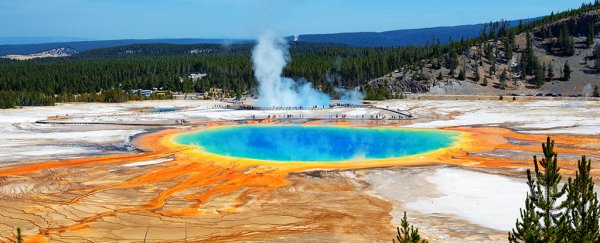Beneath Yellowstone National Park, a beast slumbers. Recent rumblings might be of interest to volcanologists, but for those fearing a cataclysmic eruption it seems as if we have little to worry about. For now.
But new research has forced a rethink on just how much time we would have up our sleeves should Yellowstone's supervolcano show signs of waking. The short answer – not as long as we'd thought.
Researchers from Arizona State University presented their findings at the 2017 International Association of Volcanology and Chemistry of Earth's Interior conference in Oregon last month.
An analysis of fossilised ash deposits taken from Yellowstone's Lava Creek Tuff revealed crystals left over from a previous eruption some 630,000 years ago.
The sizes of crystals reflect changes in temperature of their surroundings, so measuring the different crystals in layers of rock sample can tell a story of heating and pressure over a period of time.
In this case, the time between a fresh injection of hot magma from deep underground and eruption was measurable in decades, suggesting the first volcanologists to discover Yellowstone was stirring might live long enough to see her blow her top.
"It's shocking how little time is required to take a volcanic system from being quiet and sitting there to the edge of an eruption," researcher Hannah Shamloo told Shannon Hall at the New York Times.
Previous research indicated the time between a magma recharge and supervolcano Armageddon could be as long as a few millennia to just a few centuries.
Supervolcanos are basically normal volcanos on steroids, spread out over a wider area underground.
By the textbook, they're volcanic centres that have an eruption of magnitude 8 on the Volcano Explosivity Index (VEI).
That means it can vomit up more than 1,000 cubic kilometres (240 cubic miles) of hot rock and ash.
By comparison, the 1883 Krakatoa eruption was only a VEI 6 event, ejecting about 20 cubic kilometres of material.
About 640,000 years ago, Yellowstone's supervolcano blew out a chunk of the crust that left a caldera about 50 by 70 kilometres (roughly 30 by 45 miles) in size, which was quickly filled with lava.
Its last eruption was 174,000 ago, though lava was still flowing up until 70,000 years ago.
Today it's relatively quiet, with no indication of an imminent repeat of past tantrums. We might have more to worry about from Italy's Campi Flegrei supervolcano than the behemoth beneath Yellowstone.
Geologists are keeping a close eye on its seismic activity, however, and researchers are considering ways to help Yellowstone keep its cool should it start to heat up again in the future.
As unlikely as an eruption might be in the near future, a repeat VEI 8 event would be a rather bad day for humanity, throwing enough ash into the atmosphere to make our current climate change problems a low priority.
Not to mention the hell that would be unleashed on the surrounding US states of Montana, Idaho, and Wyoming.
Having better models on the timing and volcanic processes would help narrow down predictions and establish possible measures that might buy time, if not head off another eruption completely.
This research is a step in that direction, but far more evidence is needed.
"It's one thing to think about this slow gradual buildup – it's another thing to think about how you mobilise 1,000 cubic kilometres of magma in a decade," says geochemist Kari Cooper, who wasn't involved in the research.
That's a lot of hot rock oozing underfoot, and geologists are still learning how all that moving magma transforms into an Earth-shattering boom.
Let's hope we still have plenty more decades to figure it out.
